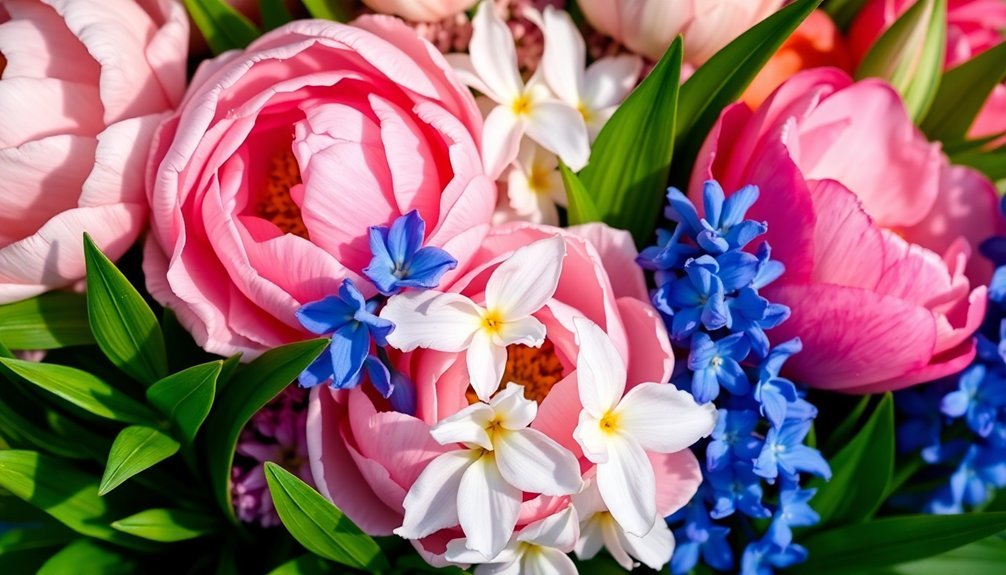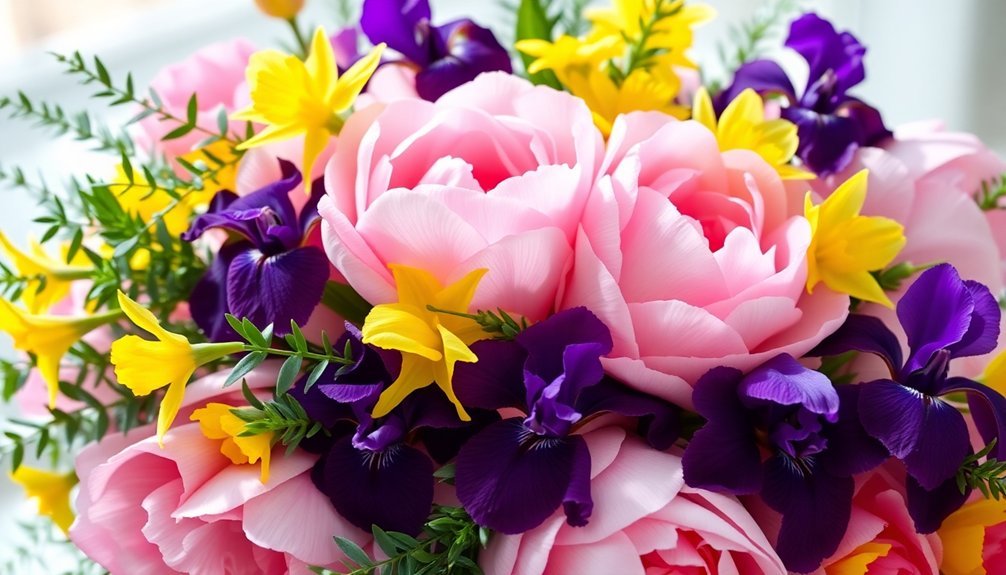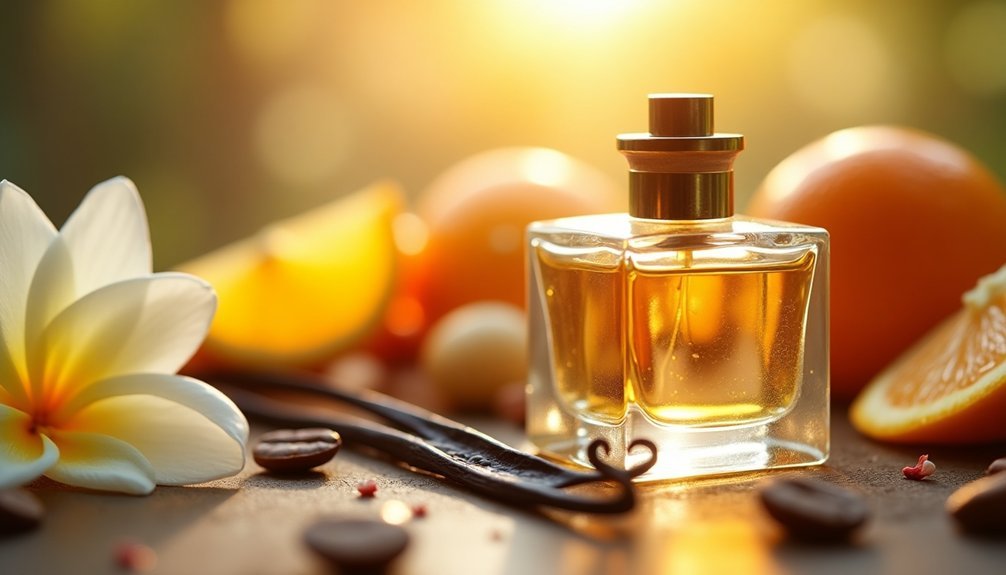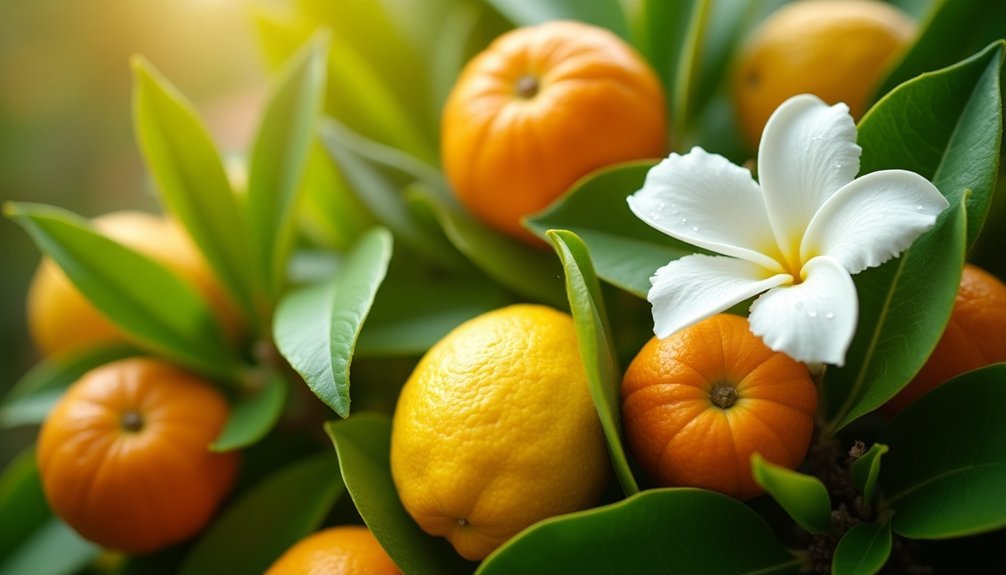You'll find several proven spring floral combinations that create stunning scents. Start with rose and cedarwood for an earthy foundation, or try jasmine with bergamot for sophisticated elegance. Magnolia paired with pine delivers fresh meadow vibes, while ylang ylang and patchouli offer perfect balance. For a bright, herbaceous blend, mix geranium with rosemary. These trusted pairings just scratch the surface of nature's aromatic possibilities.
Essential Floral Notes and Their Natural Pairings

When creating fresh spring blends, floral essential oils offer endless possibilities for natural and harmonious combinations.
You'll find that rose pairs beautifully with cedarwood for a grounding effect, while jasmine and sandalwood create a romantic atmosphere. If you're looking for balance, try ylang ylang with patchouli or geranium with rosemary. Remember to store your blends in dark glass bottles to preserve their potency.
For a fresh spring meadow scent, combine magnolia with fir or pine oils. You can also mix floral notes with herbaceous ones – jasmine and basil capture the essence of early spring, while lavender and chamomile provide soothing benefits.
If you want to enhance emotional balance, blend rose with geranium or ylang ylang. For added depth, try mixing floral oils with spicy notes like bergamot or clary sage.
Blending Floral Oils With Citrus for Balance
The art of blending floral oils with citrus creates a perfect balance between sweet and fresh notes.
These essential oils from citrus peels provide bright and invigorating notes that bring a refreshing dimension to floral blends.
You'll find that combining these scents not only enhances their individual qualities but also produces complex, therapeutic fragrances that can uplift your mood and reduce stress.
When you're ready to experiment with citrus-floral combinations, try these proven pairings:
- Bergamot with jasmine for a sophisticated, sensual blend
- Lemon with rose to add zesty brightness to romantic notes
- Mandarin with orange blossom for a harmonious, sweet profile
- Grapefruit with neroli to create a tangy, honeyed fusion
For the best results, start with a citrus base layer at your pulse points, then add floral undertones.
You'll want to finish with subtle musky notes to guarantee your blend has lasting power throughout the day.
Creating Long-Lasting Spring Bouquet Scents

Creating enchanting spring bouquet scents requires a thoughtful blend of long-lasting flowers and proper maintenance techniques.
You'll find success by pairing peonies with roses for a classic floral bouquet that offers both citrusy and traditional rose notes. For a unique blend, try combining lavender with hyacinths – you'll get a calming yet invigorating scent that can last over a week with proper care. Hyacinths contribute a distinctive green vegetal aroma that adds wonderful depth to any spring arrangement.
To guarantee your fragrant bouquet stays fresh, trim the stems at an angle and place them in lukewarm water.
Don't forget to change the water every few days and keep the flowers away from direct sunlight. You can extend their life by adding a mixture of sugar and white vinegar to the water or using commercial flower preservatives.
Seasonal Mixing Ratios for Optimal Results
You'll find success in spring floral blends by starting with proven ratios, such as 4-8 drops of lavender to 1 drop of chamomile for a balanced foundation.
When creating complex floral mixes, combine 2 drops each of gardenia and tuberose with single drops of lavender and ylang ylang to achieve a harmonious bouquet effect.
For fresh, herbaceous combinations, mix equal parts (2 drops each) of basil, lemon, and jasmine to capture the essence of spring.
Blending Basics and Ratios
Mastering essential oil ratios forms the foundation of successful spring floral blends. You'll want to follow the classic 30-50-20 rule: 30% top notes, 50% middle notes, and 20% base notes.
When working with spring florals, it's crucial to take into account both the ratio and the aroma strength of each oil.
- Start with a 100-drop base formula to easily calculate your percentages.
- Test each oil's strength using perfume strips before combining.
- Adjust ratios based on potency – use just 1 drop of strong oils like chamomile to 4-8 drops of milder ones like lavender.
- Blend multiple oils within each note category while maintaining the overall ratio (example: 20% top note can be split between basil and lemon).
Remember to pause and inhale between additions, letting the developing aroma guide your next choice.
Time-Tested Spring Combinations
Building on our foundational blending principles, successful spring combinations draw inspiration from nature's own perfect ratios.
You'll find that tulips and ranunculus create a romantic duo when mixed in equal parts, while adding 20% lilacs brings both fragrance and visual depth to the arrangement.
For a classic spring display, combine two parts daffodils with one part forsythia, using the yellow blooms to create a striking focal point.
Sweet peas and lilacs work beautifully in a 1:1 ratio, especially when you incorporate 30% viburnum for texture.
Looking for height variation? Mix snapdragons and petunias in a 2:1 ratio, then add azaleas as accent flowers at 25% of the total composition.
These time-tested ratios guarantee your arrangements maintain both balance and visual interest.
Basic-to-Advanced Floral Layering Techniques

While creating stunning floral arrangements may seem intimidating at first, understanding the progression from basic to advanced layering techniques will transform your approach to floral design.
You'll want to master these core techniques to build confidence and skill.
- Start with foliage as your foundation, then gradually add larger flowers to establish depth and structure before incorporating smaller blooms.
- Practice the spiral stemming technique, turning the bouquet as you add each flower to achieve a full, rounded shape.
- Create visual interest by combining contrasting textures – pair smooth rose petals with spiky thistles or fluffy pampas grass.
- Use the European hand-tie method to secure your arrangement, placing stems diagonally while maintaining a natural, cohesive look.
For a modern twist, try clustering similar flowers together or incorporating intentional negative space between blooms.
Therapeutic Benefits of Spring Floral Combinations
Your spring floral combinations can do more than beautify your space – they're powerful mood-enhancing tools that naturally boost your emotional well-being.
You'll find that sunflowers and gerberas work together to create an uplifting atmosphere, while lavender and jasmine provide a calming counterbalance to reduce stress and anxiety.
Mood-Enhancing Floral Properties
Spring flowers offer more than just visual appeal – they serve as natural mood enhancers with proven therapeutic benefits.
When you're feeling stressed or anxious, specific floral combinations can transform your emotional state and living space.
- Combine bright sunflowers with gerberas to create an energizing atmosphere that boosts creativity and problem-solving abilities.
- Mix lavender and jasmine for a powerful calming effect that promotes better sleep and reduces anxiety.
- Blend peonies with roses to foster emotional healing and deepen personal connections.
- Add soft pastel flowers like pink and blue blooms to create a serene environment that soothes your mind.
You'll find these combinations particularly effective in personal spaces where you spend significant time, as they provide continuous mood enhancement and emotional support throughout your day.
Anti-Stress Aromatic Effects
Beyond their visual impact on mood, certain spring flowers release powerful aromatherapeutic compounds that naturally reduce stress and anxiety. You'll find lavender particularly effective when placed in your bedroom or diffused as an essential oil for better sleep. For enhanced calming effects, try combining chamomile with lavender in teas or aromatherapy applications.
| Flower Blend | Therapeutic Benefit |
|---|---|
| Lavender + Chamomile | Deep relaxation, improved sleep |
| Sunflower + Jasmine | Mood elevation, reduced anxiety |
| Lavender + Calendula | Stress relief, skin healing |
| Chamomile + Echinacea | Emotional balance, immune support |
Create your own healing garden by incorporating these therapeutic combinations. You'll maximize the stress-reducing benefits by regularly tending to your garden while enjoying the natural aromatherapy these flowers provide.
Common Mixing Mistakes and How to Fix Them

When creating floral arrangements or essential oil blends, understanding common mixing mistakes can prevent disappointing results and wasted materials. Simple errors like cutting stems straight across or mixing incompatible flowers can greatly reduce your arrangement's lifespan and visual appeal.
- Always cut flower stems at an angle underwater to maximize water absorption and prevent stem sealing.
- Research flower compatibility before mixing – for example, keep daffodils separate from tulips due to toxic secretions.
- Follow the 1.5-2x vase height rule for stem length, and balance focal flowers with fillers and greenery.
- Remove all leaves below the waterline and change water regularly to prevent bacterial growth.
For essential oil blends, start with proven combinations like the After Rain Blend or Meadow Walk Blend, which are specifically formulated to work together harmoniously.
Frequently Asked Questions
Can Floral Essential Oil Blends Trigger Seasonal Allergies?
Yes, floral essential oil blends can trigger your seasonal allergies. You'll want to perform patch tests first, as certain oils like lavender and geranium might cause reactions, especially if you're already allergy-sensitive.
How Do Humidity Levels Affect the Intensity of Spring Floral Blends?
You'll notice that high humidity slows down your floral blend's evaporation rate, making scents last longer but potentially less intense. It can also affect how you perceive different fragrance notes in the blend.
Are Synthetic Floral Oils Safe to Mix With Natural Essential Oils?
Yes, you can safely mix synthetic and natural oils if you're using high-quality fragrance oils free from harmful chemicals. They'll work together effectively, but always check the manufacturer's guidelines and do a patch test first.
Which Floral Blends Are Safe to Use Around Pets and Children?
You'll find roses, orchids, gerbera daisies, and sunflowers make safe floral blends around pets and children. For variety, add snapdragons or freesia, but avoid toxic flowers like lilies and hydrangeas.
Do Floral Essential Oils Lose Potency if Stored With Citrus Oils?
You'll want to store your floral and citrus oils separately. While they won't directly affect each other's potency, they have different storage needs – citrus oils degrade faster and require cooler temperatures than florals.
In Summary
You've learned the foundations of spring floral blending, from pairing jasmine with ylang-ylang to balancing rose with citrus notes. Remember to start with a 2:1 ratio when mixing florals, and don't overpower lighter scents with heavier ones. Trust your nose, experiment with seasonal combinations, and you'll create unique, therapeutic blends that capture spring's essence. Keep these guidelines handy as you develop your signature springtime fragrances.
References
- https://mymoonstonekitchen.com/blog/fresh-and-floral-essential-oil-blends-for-spring
- https://www.mynewroots.org/2013/02/the-life-changing-loaf-of-bread/
- https://aromaenergy.co.uk/blogs/essential-oils/spring-essential-oil-blends-the-complete-guide
- https://blog.propllr.com/how-to-do-content-research-for-blog-posts
- https://gyalabs.com/blogs/diy-recipes/floral-essential-oils-blend-recipes
- https://achs.edu/blog/blending-101-the-art-of-pairing/
- https://comegic.org.mx/wp-content/uploads/2023/06/Como-escribir-articulo-cientifico.pdf
- https://www.alphaaromatics.com/blog/floral-scents/
- https://anthonymarmin.com/the-perfume-blog/citrus-in-perfumery
- https://www.nisarabeauty.com/blogs/blogs/how-to-layer-citrus-perfumes-for-an-energizing-start-to-the-day
- https://blog.whimsyandwellness.com/the-24-spring-diffuser-blends-we-cant-stop-diffusing/
- https://culinarysolvent.com/blogs/alcohol-for-perfumers/diy-fragrance-scent-profiles-and-sources
- https://methrashop.co/blogs/news/pairing-scents-what-to-wear-with-your-orange-blossom-perfume
- https://experimentalperfumeclub.com/smell-spring-three-fragrance-notes-evoke-springtime/
- https://redacaocientifica.weebly.com/uploads/6/0/2/2/60226751/scientific_writing_2.0_-_a_reader_and_writer’s_guide.pdf
- https://spongelle.com/blogs/blog/floral-scents-for-spring
- https://emotrab.ufba.br/wp-content/uploads/2020/09/Saldana-2013-TheCodingManualforQualitativeResearchers.pdf
- https://www.thoughtfulmisfit.com/blog/the-longest-lasting-flowers-to-buy-in-spring
- https://njaes.rutgers.edu/fs1220/
- https://masterblogging.com/blog-post-research/





Leave a Reply